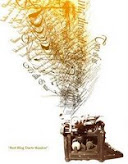So many awesome things happen in April and I want to be sure you know about some of the things I'm exited about.
First, April is Script Frenzy! If you've been reading this blog for awhile, you'll remember that National Novel Writing Month happens in November every year. Script Frenzy is hosted by the same wonderful group of people. In April, adults are challenged to write a 100-page script in 30 days. For kids 12 and under, or classes of students in kindergarten through 12th grade, there is a Young Writers Program complete with a writer's resources section that teaches you how to write a script. The site even offers safe, kid-friendly chat rooms.

I will not be participating in Script Frenzy but I will be working on a new novel in April while some of the members of my writing group work on scripts. I will set a much smaller word-count goal for April than I did in November but I will post a word counter in the sidebar so you can keep track of my progress if you're interested. I hope you'll write along with me!
Second, April is National Poetry Month! I urge you to check out 30 Poets/30 Days at GottaBook where Gregory K. will poet a new poem for kids everyday of April. The poems are all previously unpublished. The poets who are participating include Jon Scieszka (who wrote Seen Art and Math Curse, which you've read about here) and Jane Yolen. The celebration begins on April 1 with a poem by the former Children's Poet Laureate, Jack Prelutsky.

If you want to write some poems of your own, you might consider looking to art for inspiration!
And finally, April is the first full month of spring! Warm weather is on its way. Make sure to get outside and enjoy it! If you live in the D.C. area, the National Cherry Blossom Festival is underway. The peak bloom period is expected to begin on April 1 and continue through April 4, but the cherry trees have already begun to blossom. There will be a parade in the city on Saturday, April 4 and there are sure to be tons of people enjoying the cherry trees.

I took the above photo last year. I'm not sure if I'll be able to see the cherry blossoms this year, but I am certainly going to try!
What does any of this have to do with art? Well, script writing is an artform, poetry is an artform, and if you take photos at the National Cherry Blossom Festival, photography is an artform, too.
I can't wait for April!


 Supplies Needed:
Supplies Needed: This is a messy one. If you’re having nice weather I recommend taking your whole art studio outside today. Wear old clothes and, no matter what, cover your workspace.
This is a messy one. If you’re having nice weather I recommend taking your whole art studio outside today. Wear old clothes and, no matter what, cover your workspace. You want to use a dry brush for this. A hard-bristled toothbrush would be better than a paintbrush. Squirt some paint onto the end of your brush. Aim the brush at the pot and run your thumb across the bristles. This will send the paint flying in all directions. That’s why you’re outside and wearing old clothes!
You want to use a dry brush for this. A hard-bristled toothbrush would be better than a paintbrush. Squirt some paint onto the end of your brush. Aim the brush at the pot and run your thumb across the bristles. This will send the paint flying in all directions. That’s why you’re outside and wearing old clothes! Rinse the brush and then squirt a new color onto the bristles. Splatter the paint across the pot. Continue adding colors until you are happy with your pot. Do the same with the saucer. It will save you some time and brush washings if you do the pot and the saucer at the same time.
Rinse the brush and then squirt a new color onto the bristles. Splatter the paint across the pot. Continue adding colors until you are happy with your pot. Do the same with the saucer. It will save you some time and brush washings if you do the pot and the saucer at the same time. When the pot has dried (about 30 minutes), paint black lines between each square, rectangle, and line.
When the pot has dried (about 30 minutes), paint black lines between each square, rectangle, and line. You may want to let the pot dry and do another coat of stripes in the opposite direction (from the lip to the base). I chose not to.
You may want to let the pot dry and do another coat of stripes in the opposite direction (from the lip to the base). I chose not to.



 Print a blank map like
Print a blank map like  Next, label the states. This is where having a larger map comes in handy. It might even be a good idea to print the map in sections onto several sheets of paper and then tape or glue them together when you finish. Use your white crayon to write the names of the states on the map. You’ll want to use abbreviations for some of the smaller states. In my example, I only labeled a few of the states. You should label them all.
Next, label the states. This is where having a larger map comes in handy. It might even be a good idea to print the map in sections onto several sheets of paper and then tape or glue them together when you finish. Use your white crayon to write the names of the states on the map. You’ll want to use abbreviations for some of the smaller states. In my example, I only labeled a few of the states. You should label them all. When you’ve finished, the state lines and names will stand out against the colors of your map. Hang and enjoy!
When you’ve finished, the state lines and names will stand out against the colors of your map. Hang and enjoy! “This award acknowledges the efforts that every blogger shows in his/her effort to transmit cultural, ethical, literary, and personal values every day.”
“This award acknowledges the efforts that every blogger shows in his/her effort to transmit cultural, ethical, literary, and personal values every day.” Well, it all started with an illustrator named Randolph Caldecott. Throughout his life, he created artwork for magazines. He illustrated novels and drew cartoons. He sculpted and painted. He even illustrated his letters, drawing pictures around the edges of the pages.
Well, it all started with an illustrator named Randolph Caldecott. Throughout his life, he created artwork for magazines. He illustrated novels and drew cartoons. He sculpted and painted. He even illustrated his letters, drawing pictures around the edges of the pages. In 1938, the Association for Library Service to Children awarded the first Caldecott Medal. The award was named in honor of Randolph Caldecott and the winner had to contribute to children’s literature the way Caldecott had. The illustrations had to be original artwork and they had to help tell the story.
In 1938, the Association for Library Service to Children awarded the first Caldecott Medal. The award was named in honor of Randolph Caldecott and the winner had to contribute to children’s literature the way Caldecott had. The illustrations had to be original artwork and they had to help tell the story. Supplies Needed:
Supplies Needed: I’m going to walk you through the steps to create this bird, but keep in mind that you can make any animal like this. If you have been studying butterflies for example, you might want to make a butterfly.
I’m going to walk you through the steps to create this bird, but keep in mind that you can make any animal like this. If you have been studying butterflies for example, you might want to make a butterfly. Next, prepare the cardboard. This will become your tree. Peel the back off of the cardboard so you’re left will ridges. Squeeze some brown paint onto a palette or plastic lid. Cut another small strip of cardboard and dip the edge in the paint. Dab off some of the paint and then stamp the edge onto the large piece of cardboard several times. You’re just trying to make the cardboard look more like a tree. Work until you’re happy with the look of your tree, then set it aside to dry. It will dry quickly.
Next, prepare the cardboard. This will become your tree. Peel the back off of the cardboard so you’re left will ridges. Squeeze some brown paint onto a palette or plastic lid. Cut another small strip of cardboard and dip the edge in the paint. Dab off some of the paint and then stamp the edge onto the large piece of cardboard several times. You’re just trying to make the cardboard look more like a tree. Work until you’re happy with the look of your tree, then set it aside to dry. It will dry quickly. Next, glue down the leaves and grass. Use white glue when gluing to cardboard (because of the ridges) and a glue stick when gluing to the background page.
Next, glue down the leaves and grass. Use white glue when gluing to cardboard (because of the ridges) and a glue stick when gluing to the background page. Remember to sign your name somewhere on your masterpiece!
Remember to sign your name somewhere on your masterpiece!


